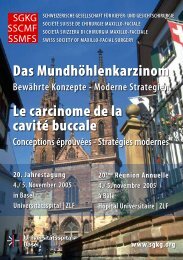ÖGMKG - und Gesichtschirurgie
ÖGMKG - und Gesichtschirurgie
ÖGMKG - und Gesichtschirurgie
Sie wollen auch ein ePaper? Erhöhen Sie die Reichweite Ihrer Titel.
YUMPU macht aus Druck-PDFs automatisch weboptimierte ePaper, die Google liebt.
Kolk, Andreas<br />
Der modifizierte nicht-virale Gentransfer von BMP-2 aus einer biodegradierbar beschichteten<br />
Titanoberfläche konnte erstmals erfolgreich in vitro <strong>und</strong> in vivo etabliert werden. COPGROG´s<br />
wie auch PDLLA-Oberflächen schützen den Vektor im Vergleich zu konventionellen Gen-<br />
vektoren vor Protein bedingter Destabilisierung. Tierexperimentell konnte ein gegenüber der<br />
Kontrollgruppe signifikant gesteigerter osteoinduktiver Effekt ohne überschießendes Wachstum<br />
nachgewiesen werden, während das rekombinante Protein zu einer schnelleren, aber auch<br />
überschießenden, unkontrollierten Neubildung führte.<br />
Pautke, Christoph<br />
Polychrome sequential labelling of bone using different tetracyclines and<br />
spectral image acquisition (Se07-05)<br />
Christoph Pautke 1, Thomas Tischer 2, Stephan Vogt 2, Cornelia Haczek 1, Stefan Milz 3 An-<br />
dreas Neff 1, Hans-Henning Horch 1, Andreas Kolk 1 (christoph.pautke@gmx.net)<br />
1: Department of Oral and Maxillofacial Surgery, Technical University of Munich, Germany 2:<br />
Department of Orthopedic Surgery, Technical University of Munich, Germany 3: AO Research<br />
Institute, Davos<br />
Backgro<strong>und</strong><br />
Polychrome sequential labelling of bone is the standard investigation technique to analyse<br />
bone growth or regeneration in vivo. Due to the fact, however, that the fluorochromes are not<br />
approved for a human application, this technique can only be applied in animal models. An<br />
exception are tetracycline and its derivates revealing a yellowish fluorescence. Because the<br />
fluorescence of all tetracyclines is very similar, they cannot be distinguished by conventional<br />
methods (different fluorochrome filter sets).<br />
The aim of this study was therefore to establish a polychrome sequential labelling of bone using<br />
different tetracyclines and spectral image analysis.<br />
Material and Methods<br />
For this purpose 15 male Wistar rats (5 weeks old, appr. 200g) received 9 different tetracyclines<br />
(Chlortetracyclin, Chlorotetracyclin Demeclocyclin, Doxycyclin, Methacyclin, Minocyclin, Oxyte-<br />
tracyclin, Rolitetracyclin, Tetracyclin) subcutaneously either as a single application (in order to<br />
define the pure respective fluorochrome spectrum) or sequentially in a three day interval. Bone<br />
specimen were harvested and embedded in methylmetacrylate. Bone Analysis was performed<br />
using spectral image acquisition (Spectral Cube SD-300, Applied Spectral Imaging, Israel).<br />
50 51<br />
Results<br />
Each tetracycline derivate revealed a characteristic fluorescence spectrum. 4 out of the 9 tetra-<br />
cyclines were distinguishable using spectral image analysis. After linear unmixing, the 4 suita-<br />
ble tetracyclines could be singly depicted when applied in a polychrome sequential labelling.<br />
Discussion<br />
The technique of polychrome sequential labelling is feasible using different tetracycline deri-<br />
vates and spectral image analysis. Having established this polychrome bone labelling tech-<br />
nique, the transfer to human application is possible for the first time.



